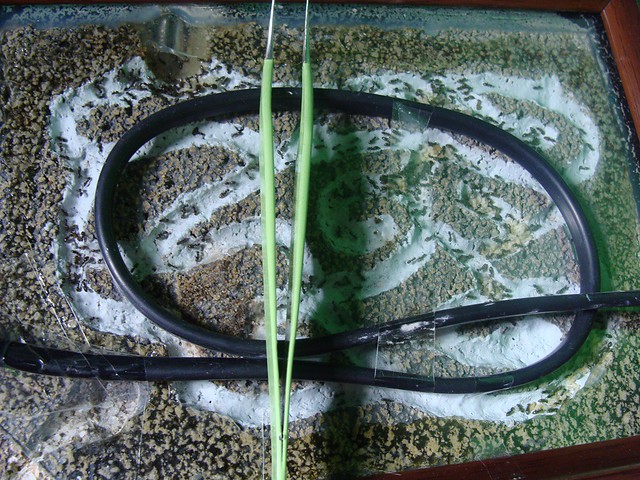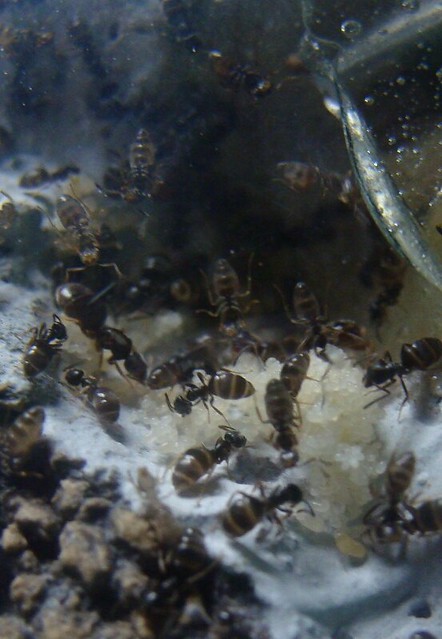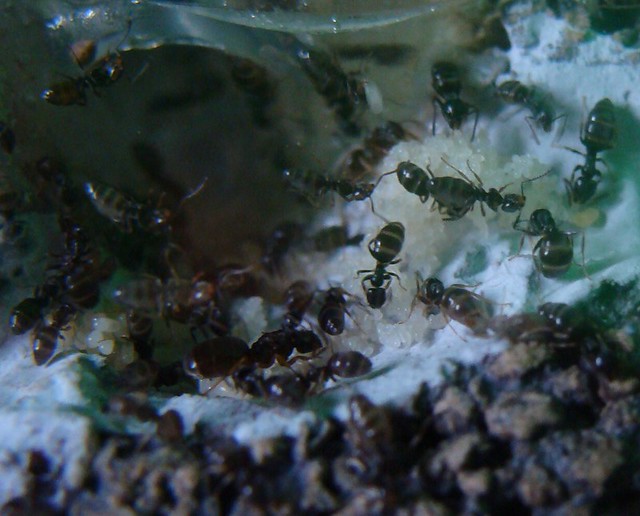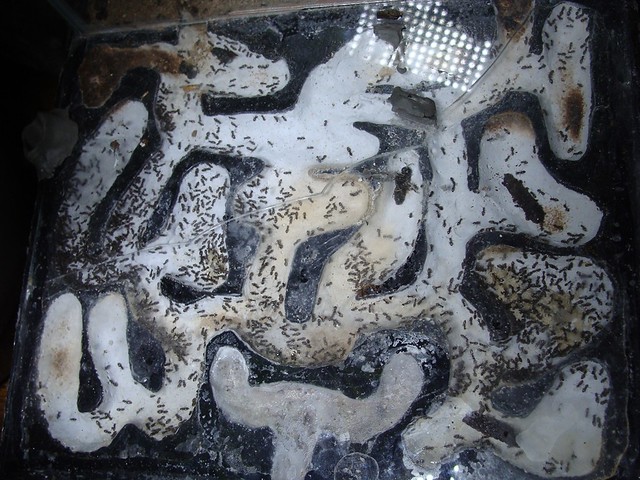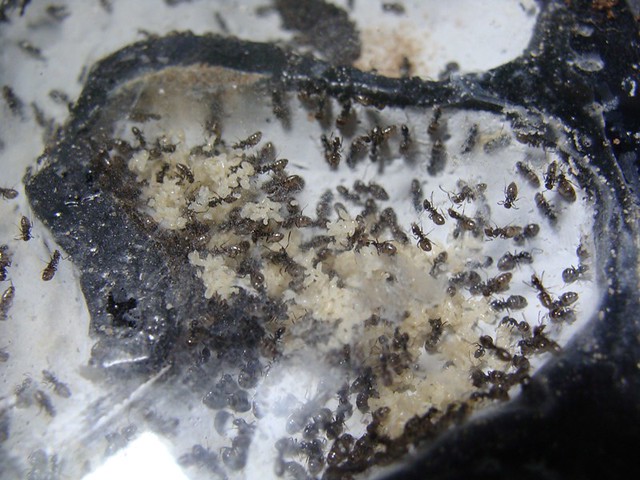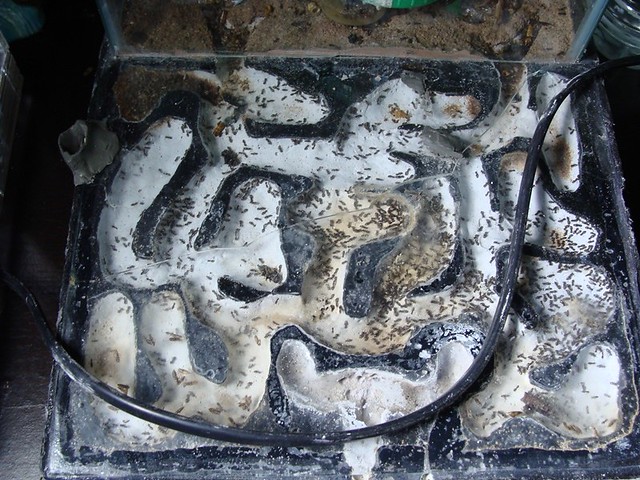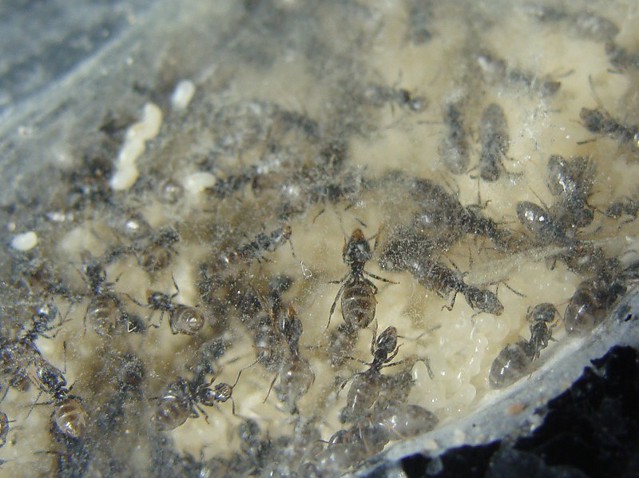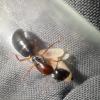Update: Please note that this colony was sold to gpoon in October 2015 and I have changed the title to reflect this.
July 2014.
I found a small colony of Tapinoma sessile in Fairmont Hotsprings. I have only ever found one colony to date. It was on the side of a mountain, in a pile of spruce needles, over 2km from the nearest human building. Go figure.
I collected 3 queens and about 100 workers. I left the other queens and workers.
The first 2 weeks they were very fussy on what they ate.
During this time I also learned how dangerous condensation was for them (lost a worker or two).
I also learned how much they crave heat. I had to double up my 15 watt heating cable before they were happy. I put a thermometer on the glass 3mm from the heat cable and got a reading of 36C (96.8F).
Here is about 3 months after capture, in a 4x5" nest. The queens have started laying eggs. At the peak, they had a pea sized pile of eggs.
The eggs developed into larvae, but the larvae never developed into pupae. After 2 months of no development and minimal foraging I knew they were waiting for hibernation, this behavior is exactly like my Lasius colony when they were ready for hibernation.
January 2015.
After one month I got impatient and brought them out around mid January 2015. They didn't seem to mind the short "winter".
Moved them into a larger nest and thus discovered how hard it is to convince Tapinoma to move. For a species that is rumored to constantly move about, merge and split colonies, it took me by surprise.
Took 3 weeks of persuasion to accomplish the move with a mixture of the old nest drying out 100%, high light, high heat, vibration, and using a syringe to direct my breath into the far side of the nest. Hardest colony I have ever had to move. Not looking forward to the day I have to upgrade them again.
Once out of hibernation it didn't take long for the larvae to pupate and the queens to start laying eggs. I can't get an accurate count on the workers once the pupae eclosed, at least 200, maybe 300. I did not see any alates which saddens me as everything I find says that queens of this species do not live for more than a couple of years and I have no idea how old my queens are.
April 2015.
I did a head count April 2015 and I still have the 3 queens. Sometimes it is hard to tell because they are so small and they often hide under brood or workers.
Sorry for the cloudy glass, it seems that they like to walk upside down on it. I will have another talk with them about it, but I doubt it will do much good.
The current pile of eggs is huge, you can see it in the background. About 3cm long and 1cm wide. In the middle picture is lots of eggs, and at the very top a new callow worker. In the bottom picture you can see a silhouette of a queen.
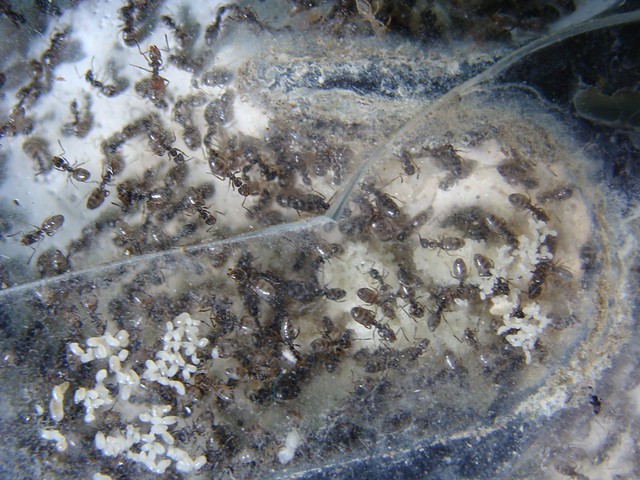
Keeping them contained is fun. Needless to say that I am glad that they do not sting or bite. The lip on the foraging area has fluon on the underside of it, but they seem to occasionally find the odd foothold to get past it. The top side of the lip was rubbed with olive oil. The lid is on little feet to keep dust off of the oil. This seems to be the best I can do with this foraging area and, if I maintain the olive oil properly, there are no escapees.
For food, they really like variety. They rarely have a stong feeding response, but since their gasters are always distended I am sure they are getting enough to eat.
They are heavy on the sweets. I always have hummingbird nectar or oriole nectar available, and spice things up with drops of other fruit juices. For insects, if I give them the same thing 3 days in a row, they barely touch it.
They tend to drink the juices and leave everything else be. They enjoy crickets, mealworms, black soldier flies, and love flightless fruit flies. They had a very good response to Aqua 300 by ByFormica and an ant food recipe from Chromerust. They seem to really like canned chicken.
They are cautious around liquid foods, but are fine with pastes and gels.
Most journals I have seen only go 3-6 months and then stop as the queens and colony died out.
We shall see how far this colony can go.
Edited by Crystals, October 30 2018 - 7:26 PM.




